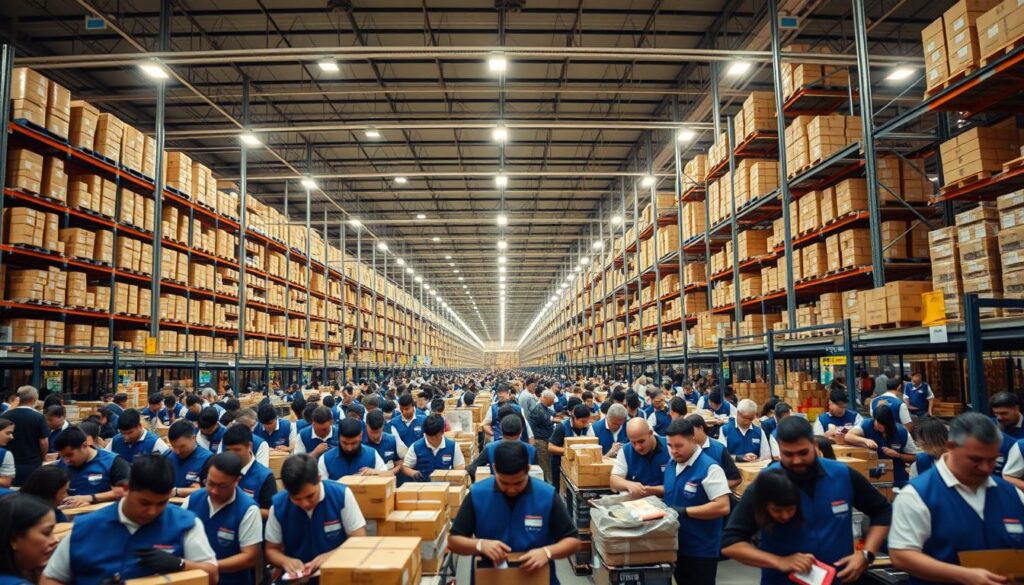Anúncios
Amazon is one of the biggest retailers worldwide, leading the way in modern labor, especially in warehouse jobs. This piece looks deeply into Amazon’s working conditions. It highlights what employees go through in the company’s vast distribution networks. Amazon is known for its innovation in ecommerce but has faced criticism over its labor practices.
We will explore what daily life is like for workers. We’ll also look at the hurdles they face while trying to meet customer needs. These challenges come as the workplace keeps changing.
Anúncios
The Rise of Amazon and its Workforce
Amazon has grown to be the biggest private job giver in the USA, with nearly a million workers. This growth proves the significant increase in jobs due to factors like evolving from a small online bookstore into a major online seller. The need for more online shopping led to big hiring efforts to handle and expand operations well.
As Amazon got bigger, keeping enough employees became a big deal. High worker turnover is a big challenge for companies. It makes us think about job happiness and strategies for keeping workers long-term. To keep up in a tough job market, Amazon started various programs and incentives. These aim to boost worker happiness and lower the number leaving the company.

In closing, Amazon’s growth has not just shown a big increase in jobs. It also brought to light the tough parts of managing a lot of workers in a fast-changing retail world.
Challenges in Amazon Warehouses
Amazon warehouse challenges are key topics in discussions about the company’s work conditions. Employees deal with tough workloads, strict goals, and always being watched. This leads to a lot of stress and burnout for many workers.
Many workers find it hard to handle conditions like extreme temperatures, which hurt their health. Also, very strict timing rules make them fear not meeting their work quotas.
These issues lead to labor problems, putting Amazon’s workforce in a tough spot. Many employees leave their jobs looking for better places to work. Both current and past employees talk about how hard their jobs were. They discuss the physical and mental stress they faced.
The Reality of Job Demands and Productivity
Amazon’s workforce faces unique challenges due to Amazon job demands. The company is known for setting high productivity expectations. This pushes workers to maintain an intense work pace, which can be overwhelming and stressful.
High Expectations for Work Pace
Amazon expects a lot when it comes to how fast employees work. Workers have to meet tough goals that demand speed in task completion. They also face close monitoring by management.
This scrutiny can lead to pressure, as not meeting goals might result in negative feedback or job loss. This environment favors productivity but can neglect employee well-being.
Consequences of Low Productivity
Falling short of productivity expectations at Amazon has real effects. Employees dealing with this pressure can feel very anxious. This worry can harm their physical and mental health.
An environment that values numbers over people creates stress. If an employee’s output drops, the resulting stress can be overwhelming.
What is it like to work at Amazon
Working at Amazon offers different experiences to employees. It depends on the job location and role. Many find the fast-paced nature of the work challenging but rewarding. Some praise the company for its competitive pay and health benefits. Yet, others find the workload during busy seasons tough.
Worker Experiences from Various Locations
Employees from various Amazon locations have shared their thoughts. Many like the good pay and chances to move up in the company. However, some talk about the hard work in warehouses during busy times. They discuss:
- Competitive pay rates with benefits that attract many to permanent positions.
- Challenging work conditions, particularly during peak times.
- Varying degrees of support from management across locations.
Temporary vs. Permanent Positions
Whether a job at Amazon is temporary or permanent affects the experience. Temporary roles offer quick money but less job security. Workers in these jobs may not get the same support as permanent employees. Permanent roles, on the other hand, often offer better chances for growing with the company.
- Temporary roles may lack the same benefits offered to permanent employees.
- Job stability is often more tenuous for temporary positions, creating stress for workers.
- Permanent positions frequently come with greater opportunities for advancement within the company.
Health and Safety Concerns
Amazon warehouse workers face major health and safety issues, especially with extreme temperatures. There are many reports of health risks at Amazon, especially in the hot summer months. Workers often suffer from heat-related illnesses. This raises questions about how effective Amazon’s safety measures are.
Extreme Temperatures and Heat Stress
Warehouse work often means long hours in hot places without enough air conditioning. This lack of cooling increases the danger from the heat. Workers complain about not getting enough breaks or water stations. These are important to avoid heat stress. With rising temperatures, the risk of heat stroke and other problems grows. This shows why it’s important to keep checking and improving safety at work.
Emergency Response Protocols
To tackle these issues, Amazon has added emergency steps, like having paramedics ready during very hot days. While this shows Amazon wants to make the workplace safer, some workers still feel at risk in many locations. It’s crucial to monitor and act quickly during health emergencies to keep workers safe. These safety plans must be reviewed regularly. They should change as needed to meet the needs of employees and the changing environment.
Unionization and Workers’ Rights
The movement toward forming unions at Amazon shows employees worrying about how they’re treated and their work conditions. In recent years, workers have been pushing for the right to negotiate together to get better rights and workplace standards. However, reaching this goal isn’t easy. Amazon has often fought against these union efforts. This situation shows a clear difference in how union and non-union workers are treated, leading to big questions about the future of workers’ rights at Amazon.
Attempts at Collective Bargaining
Workers trying to negotiate together at Amazon have made headlines across the country. They have organized campaigns to create unions. But they often face pushback from the company, which uses strategies to discourage unions. These tactics can include scaring employees or misleading them about what being in a union means. As workers fight for a collective voice, it’s tough for them to gain basic rights that many in other industries already have.
Impact of Unionization on Employee Treatment
Having unions at Amazon seems to really help with how workers are treated and their workplace conditions. Union members often talk about having better resources, more job security, and more power in job arguments. This is different from workers without a union, who might not get as good treatment. This uncertainty makes more workers interested in their rights. The chance for unions to change how Amazon workers are treated is growing. This sparks talks on how unions could change not just jobs at Amazon but the company as a whole.
Company Responses to Criticism
In recent years, Amazon faced criticism regarding its employees’ working conditions. The company has made public statements in response. These responses emphasize Amazon’s focus on worker safety and wellbeing. They aim to reassure employees and the public. However, many workers remain unconvinced. They feel the actions taken don’t fully address the important issues.
Amazon’s Statements on Working Conditions
Amazon often releases statements about its working conditions. These messages stress improvements in safety and workers’ satisfaction. The company says it’s always looking to do better, meeting standards and expectations. But many employees doubt these efforts lead to real change.
Changes Implemented in Response to Reports
Amazon has made changes in response to negative reports about its workplace. They’ve added new safety protocols, updated break policies, and hired more staff at busy times. Some progress is noted by employees. Yet, many believe these steps are not enough to overcome ongoing workplace challenges.
The Role of Oversight Organizations
Oversight organizations are key in ensuring workplace safety, especially in Amazon’s warehouses. The Occupational Safety and Health Administration (OSHA) has carried out many investigations to better the conditions for workers. These efforts help make sure safety standards are met and workers’ rights are defended.
Investigations by OSHA
Various complaints about safety issues at Amazon have led to OSHA inspections. Inspectors look at the conditions, talk to employees, and check safety rules, pointing out critical issues. OSHA’s goal is to uncover any safety problems that could harm employees.
Findings and Recommendations
OSHA’s findings often result in suggestions to make the workplace safer. These recommendations usually aim to improve how safety information is shared and add new ways to protect employees. They strive to create a safer environment where every worker’s health is a priority.
Cultural Aspects of Amazon’s Work Environment
Amazon’s work culture greatly affects employee happiness and how much they like their jobs. Many appreciate the good pay and job security Amazon offers. However, the high pressure and tough work conditions can make the good parts seem less important. It’s important to look at different views on Amazon’s work culture.
Employee Morale and Job Satisfaction
How happy Amazon employees feel can change quickly based on what happens at work. Things that affect morale include chances to move up in their careers, relationships with coworkers and bosses, and how work affects their personal life.
- Opportunities for career advancement
- The nature of relationships with colleagues and supervisors
- Work-life balance and its impact on personal lives
Job happiness is influenced by these factors, with many valuing the pay despite the stress of daily tasks. There are efforts to make a supportive work environment, but the job’s hard demands often challenge these efforts.
Impact of COVID-19 on Working Conditions
The impact of COVID-19 at Amazon led to big changes in working conditions. It brought about significant Amazon employment changes. The focus was on safety and meeting health guidelines. Employees saw both challenges and improvements at work.
Changes to Employment Standards
In response to the pandemic, Amazon made several important changes. These included:
- Increased safety protocols, such as mandatory masks and social distancing.
- Enhanced sanitation practices within warehouses and fulfillment centers.
- Temporary adjustments in productivity expectations to account for new procedures.
These changes were meant to keep workers safe. Yet, they made some rethink their job security and conditions at work. They show how Amazon shifted its focus towards employee well-being during these hard times.
Pandemic Effects on Workforce Stability
The pandemic had a big impact on workforce stability at Amazon. While some felt more secure due to online shopping demand, others felt uncertain. Main factors included:
- A surge in hiring to meet delivery service demand.
- Furloughs and job changes impacted some employees negatively.
- Concerns about health led some to take leave or quit, affecting team spirit.
This shows how COVID-19 changed the way employees felt about their jobs at Amazon.
Conclusion
The look into Amazon’s work life shows a tough situation. Corporate goals clash with what employees go through every day. Insight from workers shows a big difference between what Amazon promises and what really happens in warehouses. Employees deal with hard demands, health issues, and tough competition. Their well-being isn’t always a priority.
It’s clear Amazon needs to face these issues head-on. The company must find a balance between growing and taking care of its workers. For a better future, it’s important to focus on improving job conditions, health safety, and workplace culture.
The summary highlights a key point – worker treatment is just as crucial as business success. As conversations about worker rights grow, Amazon has a chance to set a good example. They can create a fair and caring place for everyone who works there.



